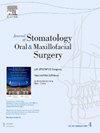Facemask application with fixed orthodontic appliances: 3-dimensional finite element stress analysis
IF 2
3区 医学
Q2 DENTISTRY, ORAL SURGERY & MEDICINE
Journal of Stomatology Oral and Maxillofacial Surgery
Pub Date : 2024-12-10
DOI:10.1016/j.jormas.2024.102195
引用次数: 0
Abstract
Introduction
Facemask(FM) is an orthopedic appliance with extraoral and intraoral anchoring units used in treatment of maxillary retrognathia. Aim of this study was to assess effects of tooth-supported FM application via fixed orthodontic appliances on craniofacial structures with finite element stress analysis.
Materials and Methods
A model was constructed on maxillary teeth with Roth brackets (0.018″slot), 0.018″x0.025″ stainless steel archwire, and crimpable hooks placed distal to upper lateral incisors. The scenario included application of FM with 350 g force, forming 30° angle with occlusal plane. Stress distributions and displacements on craniofacial bones, sutures, intraoral anchoring unit and maxillary teeth were evaluated.
Results
High stress distributions were observed in anterior maxilla, pterygomaxillary region, zygomatic arch, and frontal process of zygomatic bone. Zygomaticotemporal, zygomaticofrontal, pterygomaxillary sutures and intraoral anchoring unit showed high stress distributions too. Stresses along maxillary teeth were not uniform, declaring increased stress distributions at the anterior region, but tended to decrease to posterior. Forward displacement was observed in all landmarks and counterclockwise rotation of maxilla and dentition were observed vertically. Narrowing in maxillary dental arch was observed.
Discussion
Tooth-supported FM application over the brackets created stresses on craniofacial bones and sutures. Increased stress distribution were evident at the anterior maxillary region close to the force application points. Displacements were observed in all directions, drawing special attention to transversal narrowing and counterclockwise rotation of maxilla. In this respect, clinical attention should be made during FM application anchored from fixed braces, with either using rigid archwires or supporting mechanics with transpalatal arches.

面罩与固定正畸器的应用:三维有限元应力分析。
简介:面罩(FM)是一种带有口外和口内固定单元的矫形器具,用于治疗上颌后颌症。本研究的目的是通过有限元应力分析来评估通过固定正畸器应用牙支撑FM对颅面结构的影响。材料与方法:上颌牙模型采用Roth托槽(0.018”槽),0.018”x0.025”不锈钢弓丝,可卷曲钩放置于上侧门牙远端。场景包括施加FM 350g力,与咬合面形成300角。评估颅面骨、缝合线、口内固定单元和上颌牙的应力分布和位移。结果:上颌前、翼颌区、颧弓、颧骨额突均可见高应力分布。颧颞缝、颧额缝、翼颌缝和口内锚定单元也表现出较高的应力分布。上颌牙齿的应力分布不均匀,表明应力分布在前区增加,但有向后区减少的趋势。所有标志点前移,上颌骨和牙列垂直方向逆时针旋转。上颌牙弓狭窄。讨论:牙支持的FM应用在支架上对颅面骨和缝合线产生应力。上颌前区靠近施力点处应力分布明显增加。观察到各方向移位,特别注意上颌骨横向变窄和逆时针旋转。在这方面,临床应注意FM应用固定牙套锚定,无论是使用刚性弓线还是使用经腭弓的支持力学。
本文章由计算机程序翻译,如有差异,请以英文原文为准。
求助全文
约1分钟内获得全文
求助全文
来源期刊

Journal of Stomatology Oral and Maxillofacial Surgery
Surgery, Dentistry, Oral Surgery and Medicine, Otorhinolaryngology and Facial Plastic Surgery
CiteScore
2.30
自引率
9.10%
发文量
0
审稿时长
23 days
 求助内容:
求助内容: 应助结果提醒方式:
应助结果提醒方式:


